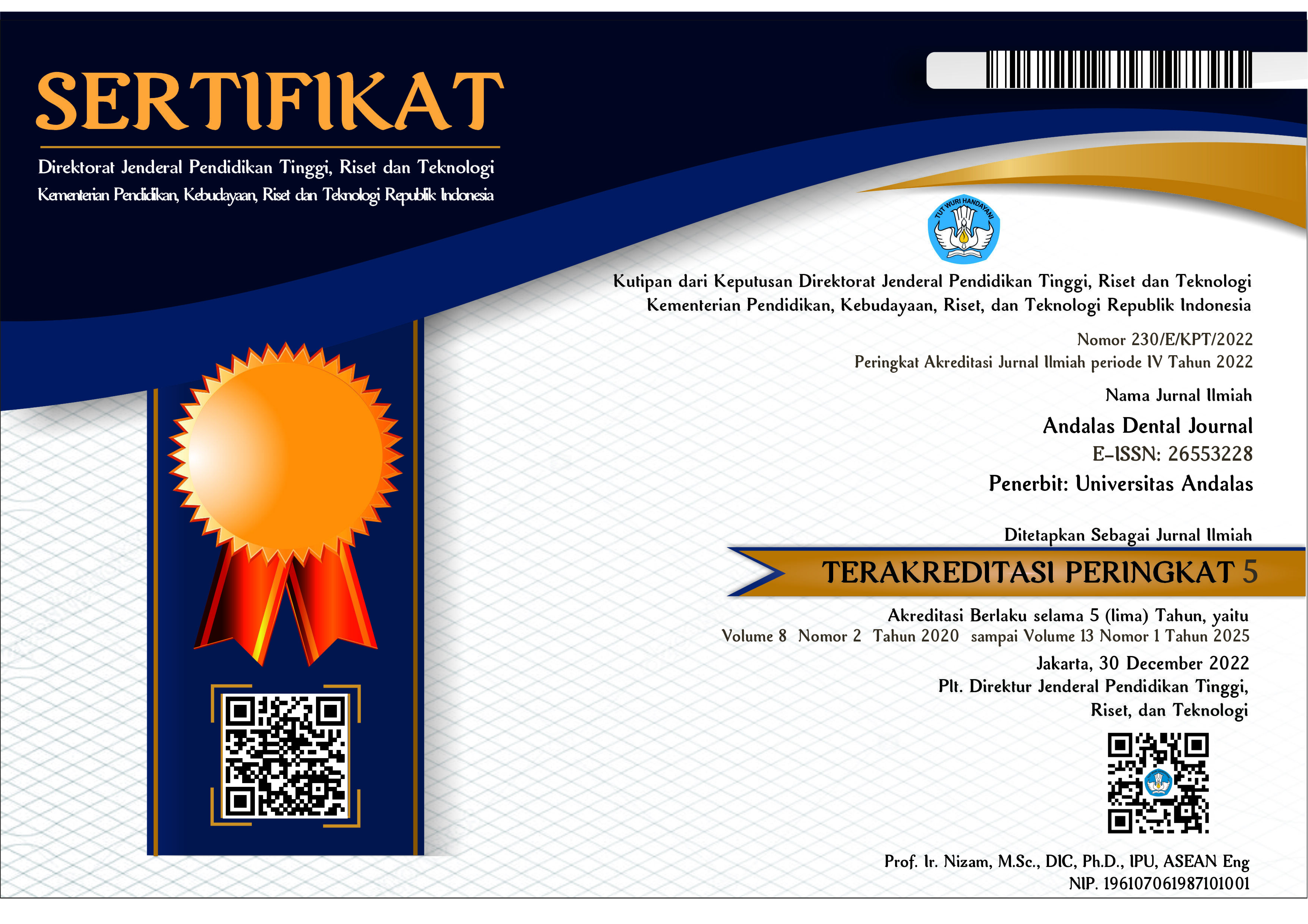Pengaruh Berkumur Dengan Larutan Teh Hijau dan Teh Hitam Terhadap pH Saliva
Abstract
The prevalence of caries in Indonesia has increased by 53.53% from 2013 to 2018. Low salivary pH (potential of Hydrogen) is one of the main causes of dental caries. Acid as metabolic product of oral microorganism can decrease the salivary pH. The purpose of this paper is to determine the effect of gargling with green and black tea solutions on salivary pH. The increasing of salivary pH linear to salivary secretion. Gargling with green tea or black tea is one of the ways that can increase salivary secretion and pH by provides a mechanical and chemical stimulus to the oral cavity. Green tea and black tea contain polyphenols (catechins) which can increase salivary pH. Conclusion is gargling with green tea and black tea solutions can add salivary pH. Gargling with green tea is more effective to increase salivary pH than black tea. Green tea has a higher catechins content than black tea, in order to anti-cariogenic and anti-bacterial properties are more common in green tea.
References
2. Vos, T., et al., Global, regional, and national incidence, prevalence, and years lived with disability for 310 diseases and injuries, 1990–2015: a systematic analysis for the Global Burden of Disease Study 2015. Health Metriks and Evaluation Journal, 2016; 388: 1551-1552.
3. Kementerian Kesehatan Republik Indonesia. Hasil Riset Kesehatan Dasar Kementerian RI 2013. Proceedings, Annual Meeting - Air Pollution Control Association, 2013, pp. 189.
4. Kementrian Kesehatan RI. Laporan Nasional RISKESDAS 2018. Badan Penelitian dan Pengembangan Kesehatan Riset, 2018, pp. 204. 2019.
5. Animireddy, D. et al., Evaluation of pH, buffering capacity, viscosity and flow rate levels of saliva in caries-free, minimal caries and nursing caries children: An in vivo study. Contemporary Clinical Dentistry Journal, 2014; 5(3): 324-328.
6. Baliga, S., Muglikar, S., dan Kale, R. Salivary pH: A diagnostic biomarker. Journal of Indian Society of Periodontology, 2013; 17(4): 461-465.
7. Hans, R., et al., Effect of Various Sugary Beverages on Salivary pH, Flow Rate, and Oral Clearance Rate amongst Adults. Scientifica Journal, 2016, pp. 1-6.
8. Shetty, C., Hegde, M. N., dan Devadiga, D. Correlation between dental caries with salivary flow, pH, and buffering capacity in adult south Indian population: An in-vivo study. International Journal of Research in Ayurveda and Pharmacy, 2013; 4(2): 219-223.
9. Fitriati, N., Hernawan, A. D., dan Trisnawati, E. Perilaku Konsumsi Minuman Ringan (Softdrink) dan pH Saliva Dengan Kejadian Karies Gigi. Unnes Journal of Public Health, 2017; 6(2): 113-122.
10. Lamont, R. J., Egland, P. G. Dental Caries. In Molecular Medical Microbiology: Second Edition, 2014, pp. 948-954.
11. Ziyaan Azdzahiy Bebe, Henry Setyawan Susanto, dan M. Faktor Risiko Kejadian Karies Gigi Pada Orang Dewasa Usia 20-39 Tahun Di Kelurahan Dadapsari, Kecamatan Semarang Utara, Kota Semarang. Jurnal Kesehatan Masyarakat (e-Journal), 2018; 6(1): 365–374.
12. Castillo Pedraza, M. C., et al., Inactivation of Streptococcus mutans genes lytST and dltAD impairs its pathogenicity in vivo. Journal of Oral Microbiology, 2019; 11(1): 1-12.
13. Kasuma, N. Fisiologi dan Patologi Saliva. Andalas University Press, 2015, pp. 7-36.
14. Nubatonis, N. D., Gunawan, P. N., and Wuisan, J. Pengaruh berkumur larutan teh hijau dalam menurunkan akumulasi plak pada gigi anak usia 8-10 tahun. Jurnal E-Gigi, 2016; 4(3): 183-187.
15. Prasanth, M. I., et al., A review of the role of green tea (camellia sinensis) in antiphotoaging, stress resistance, neuroprotection, and autophagy. Nutrients Journal, 2019; 11: 1-10.
16. Wardiyah, H., Alioes, Y., dan Pertiwi, D, Perbandingan reaksi zat besi terhadap teh hitam dan teh hijau secara in vitro dengan menggunakan spektrofotometer uv-vis. Jurnal Kesehatan Andalas, 2014; 3(1): 49-53.
17. Sangameshwar M, et al., Effect of Green Tea on Salivary Ph and Streptococcus Mutans Count in Healthy Individuals Sangameshwar M, Vanishree M, Surekha R, Santosh Hunasgi, Anila K, Vardendra Manvika, 2014; 5(1): 13–16.
18. Fajriani, F., Djide, S. Pembuatan Pasta Gigi Katekin Teh Hijau dan Uji Daya Hambat terhadap Bakteri Streptococcus Mutans dan Lactobascillus Ascidopillus. Majalah Kedokteran Gigi Indonesia, 2015; 1(1): 27-31.
19. Nedyani, V., Hayati, M., dan Bakar, A. Efek Berkumur Ekstrak Teh Hijau (Camellia sinensis) terhadap Volume dan Viskositas Saliva pada Penderita Gingivitis. Insisiva Dental Journal: Majalah Kedokteran Gigi Insisiva, 2019; 8(1): 1-8.
20. Anggayanti, N. A., Adiatmika, I., dan Adiputra, N. Berkumur Dengan Teh Hitam Lebih Efektif Daripada Chlorhexidine Gluconate 0,2% Untuk Menurunkan Akumulasi Plak Gigi. Jurnal PDG, 2013; 62(2): 35-40.
21. Arya, Vishal. Anticariogenic Activity of Black Tea - An Invivo Study. Journal of Clinical and Diagnostic Research, 2016; 10(3): 74-77.
22. Rohdiana, D. Teh: Proses, Karakteristik & Komponen Fungsionalnya. Food Review Indonesia, 2015; 10(8): 34-37.
23. Asta Tvarijonaviciute, silvia Martinez-Subiela, dan Pia Lopez-Jornet, E. L. Saliva in Health and Disease. Springer Nature Switzerland, 2020, pp 3-21.
24. Dawood, I. M., Sulafa K. El-Samarrai, P. D. Saliva and Oral Health. International Journal of Advanced Research in Biological Sciences (IJARBS), 2018; 5(7): 1-45.
25. Dawes, C., et al., The functions of human saliva: A review sponsored by the World Workshop on Oral Medicine VI. Archives of Oral Biology Journal, 2015; 60: 863-874.
26. Kumar, B., et al., The composition, function and role of saliva in maintaining oral health: A review. International Journal of Contemporary Dental and Medical Reviews, 2017; 17: 1-6.
27. Dodds, M., Roland, S., Edgar, M., & Thornhill, M. Saliva A review of its role in maintaining oral health and preventing dental disease. British Dental Journal Team, 2015, pp. 11-13.
28. Rukmo, M. Restorasi Estetik Veneer. Airlangga University Press, 2017, pp. 32-34.
29. Choi, J. E., et al., Diurnal variation of intraoral pH and temperature. British Dental Journal, 2017; 3(1): 1-6.
30. Widia, R., Kasuma, N., Comparison of Salivary pH Before and After Consuming A Solution of Sugar and Palm Sugar in Dentistry Faculty’s Student of Andalas University. Andalas Dental Journal, 2016, pp. 141-150.
31. Zabokova Bilbilova, E. Dietary Factors, Salivary Parameters, and Dental Caries. Journal of Dental Education, 2020; 32(1): 1-14.
32. Utoyo, B., Yuwono, P., dan Tri Kusumawati, W. Pengaruh Stimulasi Pemberian Tablet Hisap Vitamin C terhadap Peningkatan Sekresi Saliva Pada Pasien Gagal Ginjal Kronik yang Menjalani Terapi Hemodialisadi RS Pku Muhammadiyah Gombong. Jurnal Ilmiah Kesehatan Keperawatan, 2016; 12(1): 13-19.
33. Rika M. Alamsyah, Chindy C. Nagara. Xerostomia pada pasien hipertensi di Puskesmas Sering dan Sentosa Baru Medan. Jurnal Pdgi, 2015; 64(2): 110-115.
34. Murthykumar, K. Saliva Composition and Function: A review. International Journal of Pharmaceutical Science and Health Care Issue, 2014; 19(6): 1552-1567.
35. Petrušić, N., et al., The Effect of Tobacco Smoking on Salivation. Acta Stomatologica Croatica Journal, 2015; 49(4): 309-315.
36. Sa’adiah, H., Markus Budi Rahardjo, Sidarningsih, R. I. R. Perbedaan flow dan pH saliva pada subyek karies dan bebas karies (Difference of salivary flow and pH between caries and caries-Free Subjects), 2014; 6(1): 11–17.
37. Lely, M. A. Pengaruh (pH) Saliva terhadap Terjadinya Karies Gigi pada Anak Usia Prasekolah. Buletin Penelitian Kesehatan, 2017; 45(4): 241–248.
38. Gani, B. A., et al., The pH changes of artificial saliva after interaction with oral of artificial saliva after interaction with oral micropathogen. Dental Journal (Majalah Kedokteran Gigi), 2012; 45(4): 234-238.
39. Purwati, D. E., Sulastri, S. Pengaruh Mengkonsumsi Minuman Madu Terhadap Tingkat Keasaman pH Saliva Anak Sekolah Dasar. Jurnal Kesehatan Gigi, 2016; 03(2): 1–6.
40. Wirawan, E., Puspita, S. Hubungan pH Saliva dan Kemampuan Buffer dengan DMF-T dan def-t pada Periode Gigi Bercampur Anak Usia 6-12 Tahun. Insisiva Dental Journal: Majalah Kedokteran Gigi Insisiva, 2017; 6(1): 25-30.
41. Cholid, B. B., Oedijani, S., dan Rochmah, Y. S., Pengaruh Kumur Sari Buah Belimbing Manis (Averrhoa Carambola L.) Terhadap Perubahan pH Plak dan pH Saliva (Studi terhadap Anak Usia 12-15 Tahun Pondok Pesantren Al-Adzkar, Al-Furqon, Al-Izzah Mranggen Demak). Medali Jurnal, 2015; 2(1): 18–22.
42. Pranata, N. Dental Calculus as The Unique Calcified Oral Ecosystem A Review Article. Oceana Biomedicina Journal, 2019; 2(2): 52-64.Dewi Anjarsari, I. R. Katekin teh Indonesia: prospek dan manfaatnya. Jurnal Kultivasi, 2016; 15(2): 99-106.
43. Dewi Anjarsari. Katekin Teh Indonesia Prospek dan Manfaatnya. Jurnal Kultivasi, 2016: 15 (2):99-106.
44. Somantri, R. Iced Tea Book (R. A. Koswara, ed.). Jakarta: TransMedia. 2018.
45. Butt, M. S., et al., Black Tea Polyphenols: A Mechanistic Treatise. Critical Reviews in Food Science and Nutrition, 2014; 54(8): 1002-1011.
46. Skotnicka, M., et al., The black tea bioactivity: An overview. Central-European Journal of Immunology, 2011; 36(4): 284-292.
47. Hervina. Efek Berkumur Dengan Ekstrak Teh Hijau 3% Dalam Meningkatkan pH Saliva. Unmas Journal of Dental, 2017, pp. 1–5.
48. Prihastari, L., et al., Effectiveness of 2% Black Tea (Camellia sinensis) Infusion in Increasing Salivary pH and Fluoride in Children Increasing Salivary pH and Fluoride in Children. Journal of Dentistry Indonesia, 2019; 26(2): 99-104.
49. Mardiati, E., Prasko. Perbedaan Perubahan pH Saliva antara Berkumur Teh Celup dan Teh Tubruk pada Ibu PKK Kelurahan Muktiharjo Kidul. Jurnal Kesehatan Gigi, 2017; 04(2): 40-45.
50. Hervina. Peningkatan Kadar Bikarbonat (HCO3-) Saliva Akibat Stimulasi Mekanis Dan Kimia. Unmas Journal of Dental, 2016; 11: 37-43.
51. Kamalaksharappa, S. K., et al., Efficacy of probiotic and green tea mouthrinse on salivary pH. Journal of Indian Society of Pedodontics and Preventive Dentistry, 2018; 36(3): 279-282.
52. Rosma, M., Aritonang, N. J. Pengaruh Berkumur Dengan Larutan Teh Hijau Terhadap Ph Saliva Pada Siswa-Siswi Sd Negeri 024761 Kecamatan Binjai Utara Tahun 2014 Manta. Jurnal Ilmiah Pannmed, 2014; 9(2): 153-156.
53. Aljufri. Pengaruh Berkumur dengan Teh Hijau terhadap pH Saliva pada Murid Kelas V SDN 04 Guguk Malintang Kecamatan Padang Panjang Timur Kota Padang. Jurnal Penelitian Dan Kajian Ilmiah Menara Ilmu Universitas Muhammadiyah Sumatera Barat. 2017; 11(2): 26-30.
54. Rosma, M. Efficacy of Gargling the Green Tea Solution to the Level of pH Saliva on Teenager Students Population in Deli Serdang District of Indonesia. Journal of Medical Science and Clinical Research, 2019; 7(9): 256-260.
55. Singh, N. Effectiveness of Green Tea Mouth Rinse over Combination Mouth Rinse in Restoring Salivary pH Post Sugar Exposure in Children. Journal of Scientific Research, 2020; 64(1): 140-143.
56. Mardiati, E., Prasko. Perbedaan Perubahan pH Saliva antara Berkumur Teh Celup dan Teh Tubruk pada Ibu PKK Kelurahan Muktiharjo Kidul. Jurnal Kesehatan Gigi, 2017; 04(2): 40–45.
57. Srinidhi P. B, et al., Effect of two different commercially available tea products on salivary pH: A randomized double blinded concurrent parallel study. Dentistry and Medical Research, 2014; 2(2): 39-42.
58. Wibisono, W., et al., Black Tea and Green Tea in Reducing Children Dental Caries. Jurnal Ilmiah dan Teknologi Kedokteran Gigi, 2019; 16(1): 1-6.
59. Annita, Hendri, P. Daya Hambat Ekstrak Daun Teh Hijau (Camellia Sinensis) Terhadap Bakteri Streptococcus Mutans. Jurnal Kesehatan Saintika Meditory. 2018; 1(1): 1-9.
60. Wahyuni, A., Dewi, N., dan Yulia, B. L. Uji Efektivitas Antibakteri Sediaan Tunggal Dibanding Kombinasi Seduhan Daun Teh Hijau (Camellia sinensis) dan Madu (Studi in Vitro terhadap Jumlah Koloni Bakteri Rongga Mulut) Tinjauan pada Mahasiswa PSKG FK Unlam Banjarmasin Angkatan 2011-2013. Dentino Jurnal Kedokteran Gigi, 2016; I (2): 113–118.
61. Setianingtyas, P., Prihastari, L., dan Wardhani, N. Efektivitas Berkumur Teh Hitam Terhadap Penurunan Akumulasi Plak Pada Anak Usia 7-8 Tahun. Odonto Dental Journal, 2018; 5(1): 60-66.
62. De Assis, J. S., et al., Effect of epigallocatechin-3-gallate application for remaining carious dentin disinfection. Journal of Conservative Dentistry, 2015; 18(1): 51-55.
63. Bedran, T. B. L., et al., Black tea extract and its theaflavin derivatives inhibit the growth of periodontopathogens and modulate interleukin-8 and β-defensin secretion in oral epithelial cells. Plos One, 2015; 10(11): 1-11.















